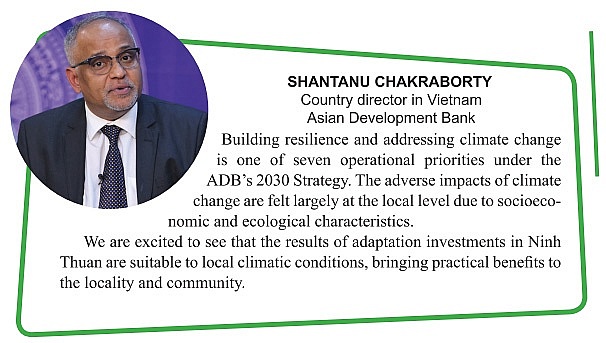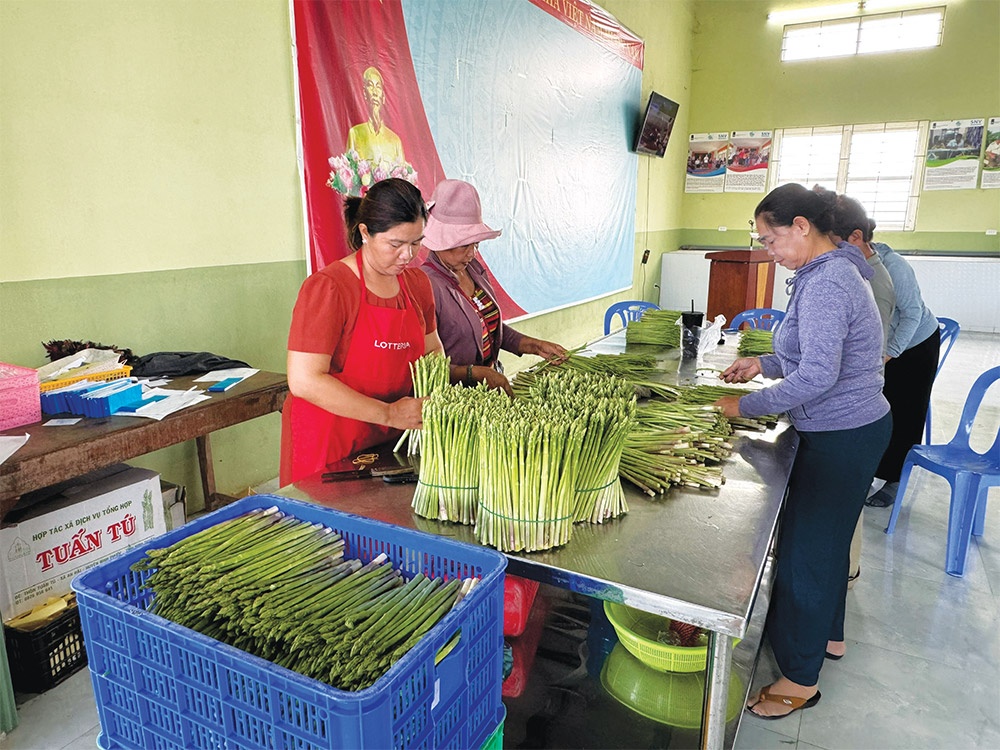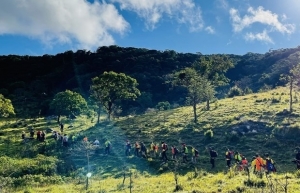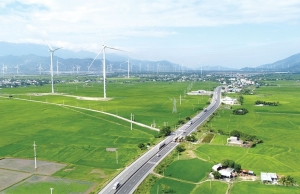Ninh Thuan inspired to form effective agriculture
On the last days of 2023, Hung Ky, chairman of Tuan Tu General Service Cooperative of Ninh Phuoc district in the south-central province of Ninh Thuan, expressed his delight at his newly built house, with a car and pickup truck in the garage.
The 54-year-old owns 21,000 square metres of land, part of which is for the house and the rest for planting asparagus and raising cows.
“Our life has remarkably changed,” Ky said. “Previously, our family members used to be hired farmers with a meagre income. We decided to shift to cultivating crops such as peanuts and carrots, but the soil was not good, making it hard for us to do this business, meaning we faced massive difficulties.”
A new door was opened to Ky in 2009 when the family started to grow asparagus, but at that time they suffered from water shortages.
“When the weather was fine, we could have sufficient water for the crop, but during the drought period, we struggled. It was not until 2017 that the locals here were provided with a large water tank by the Asian Development Bank (ADB), with water pumped from the nearby Tuan Tu dam. Since then, the life of residents here has changed,” Ky explained.
Nao Van Xay, another local in the commune, also talked about the water tank. “It has become a lifebuoy for all poor households and for the arid land area here. Over 10 years ago, this area was a miniature desert for the Cham ethnic minority. However, you can see the land covered with green asparagus thanks to the ADB’s project helping water flow,” Xay said.
 |
Irrigation development
Difficulties in agricultural production facing local inhabitants were gradually removed by Ninh Thuan People’s Committee that invested in constructing a network of irrigation works, including reservoirs, pumping stations, and canals.
However, the province partook in a governmental project on rural development in the central region (Phase 2 with additional loans) aimed at rural infrastructure development and implementation of projects for climate change response.
For this project, Ninh Thuan constructed water-saving irrigation works to produce safe vegetables under an added value chain from production to consumption. The works include upgrading the Tuan Tu dam as well as building a canal, two pumping stations, 15 tanks, a pipe system, and a system of electricity grid and power stations.
Inspired by these effective projects, Ninh Thuan continued to cooperate with the ADB to implement a project on improving water efficiency for drought-affected provinces.
The goal is to turn the arid land areas of Phuoc Nhon, Thanh Son, Nhon Hai, and Thanh Hai in the Tan My irrigation system into a high-quality agricultural production area, with a modern system originally designed for rice cultivation.
At the same time, the project aims to ensure water supply for 2,800ha of land and solve water scarcity due, while supporting farmers to switch to growing high-value crops with higher income.
In addition, the project also supports water supply and demand monitoring, as well as making drought plans and emergency plans in order to control severe droughts.
The project is divided into four construction packages, with a land area of nearly 69ha, and is being implemented from 2018 to 2026. The deployment is ensured by the Management Unit of Agricultural and Rural Development Works.
Dang Kim Cuong, director of Ninh Thuan Department of Agriculture and Rural Development, said that since 2019, the ADB has financed a pumping station to bring water from the Tuan Tu dam to the arid land area of Tuan Tu. Next, the province obtained preferential loans from the ADB to invest in five irrigation infrastructure projects with a total capital of $57 million.
“Before investing in the irrigation system, many areas of Ninh Thuan had unused water, while many places were quite dry, and hit by droughts. Now the situation has changed, with water distributed evenly according to farmers’ crops.” Cuong said.
“Farming on arid land like a desert is very difficult. Costs are high, so we have to save every drop of water. Now every family applies modern watering systems. Each area of 1,000sq.m only needs 7-9cu.m of water a day. This is very different from the previous method of overflow irrigation, which would consume more than 30cu.m of water a day.”
 |
Life improvements
While quickly arranging and tying each bunch of asparagus, Chau Thi Tram of the Cham ethnic minority in An Hai commune said that in one night, the plant grew 3cm and by 8am, the harvesting of the asparagus was completed.
On average, each area of 1,000sq.m of asparagus yields 5-7kg a day, which are sold at a market price of about $2.10 per kg. The highest productivity is seen in the third year, reaching 20kg per 1,000sq.m a day. Every year, the locals can earn an average of $16,900-21,000 per 1,000sq.m a year, which is three to four times higher than other crops in the same area.
After three months of harvesting, the plant rests for a month and then continues to be harvested for a life cycle of about nine years.
“Nowadays, almost every house in the Tuan Tu village grows asparagus, so it is very difficult to hire local workers. During the peak time, some even earned over $4.000 a month, but now it’s about $2,500. About 30 per cent of the villagers now have their own cars,” Tram said.
Along with houses growing asparagus, the Tuan Tu General Service Cooperative led by Hong Ky was established in 2016, with 13 members to share experiences and support farmers in agricultural production.
In the first year, the cooperative both purchased products from members and cooperated with a number of local businesses to sell green asparagus, with a stable price throughout the year of $2.10 per kg.
To date, the number of the cooperative’s members has increased to 84, and the area planted with asparagus has risen to more than 53ha.
After the asparagus purchase is completed at 9am, Tram and her relatives often have breakfast together. They look back to the past when the area was full of sand, which got into the house and was difficult to remove. However, the houses have now been built closer together, and where there is empty land, asparagus is planted, so sand no longer covers the area.
“In the past, when asparagus was not grown, the price of 1,000sq.m of land was $1,700, but now it has soared by 10 times, while there is no more land to buy or sell,” Tram added.
 | Ninh Thuan awards regional talents for capturing its beauty and heritage On April 14, the award ceremony for the contest was held at Nui Chua World Biosphere Reserve in conjunction with Ninh Thuan’s recognition by UNESCO and the national-level recognition for Vinh Hy Bay. |
 | F.I.T Group and Banyan Tree sign agreement for tourism project in Ninh Thuan On November 14, Cap Padaran Mui Dinh JSC and Banyan Tree Holdings Ltd. held a signing ceremony in Bangkok for cooperation in developing the Cap Paradan Mui Dinh project in Vietnam. |
 | Indian travel companies seek investment opportunities in Ninh Thuan Representatives of Indian travel companies are joining a Famtrip delegation to Ninh Thuan to seek tourism cooperation opportunities in the south-central coastal province. |
 | Positives being exploited in Ninh Thuan Ninh Thuan province boasts incredible development opportunities, with a series of vital infrastructure projects involving ports and roads being pushed forward. |
What the stars mean:
★ Poor ★ ★ Promising ★★★ Good ★★★★ Very good ★★★★★ Exceptional
 Tag:
Tag:
Related Contents
Latest News
More News
- Vingroup pulls out of bid to invest in North-South high-speed railway (December 26, 2025 | 11:42)
- Strengthening supply chains through trade promotions and customs reform (December 24, 2025 | 14:00)
- PM orders investment model for North–South high-speed rail (December 22, 2025 | 17:43)
- LS Eco Energy to invest in Vietnam rare earth sector (December 22, 2025 | 17:31)
- Government moves to establish International Financial Centre (December 21, 2025 | 21:00)
- Vietnam's IFC to target global investment flows (December 21, 2025 | 18:00)
- Two national hospitals expand capacity with new facilities (December 20, 2025 | 09:00)
- Ha Tinh breaks ground on major Vingroup industrial and energy projects (December 19, 2025 | 18:24)
- EVN launches major power infrastructure projects nationwide (December 19, 2025 | 18:17)
- VAL inaugurates second production line to meet domestic animal feed demand (December 19, 2025 | 16:37)























 Mobile Version
Mobile Version